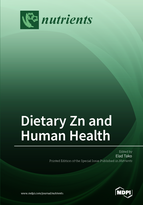Dietary Zn and Human Health
A special issue of Nutrients (ISSN 2072-6643).
Deadline for manuscript submissions: closed (15 December 2017) | Viewed by 177521
Special Issue Editor
Interests: dietary micronutrients; Fe and Zn deficiencies; anemia; Zn status biomarkers; bioactive compounds; prebiotics; microbiome; nutrigenomics; intestinal functionality and development; polyphenols; in vivo models of human nutrition
Special Issues, Collections and Topics in MDPI journals
Special Issue Information
Dear Colleagues,
Zinc is an essential micronutrient that contributes to the proper functioning of over 300 enzymes and multiple biochemical and structural processes in the body. Zinc functions in the regulation of an extensive variety of genes, such as those involved in nucleic acid metabolism, cell signalling, apoptosis, and play an integral role in immune system functioning. Even a mild Zn deficiency can profoundly affect growth and development, as well as impede immune differentiation and maturation. Zinc is widely distributed in foods, however, it was demonstrated that dietary constituents, such as phytate, polyphenols, and the intestinal microbiome, affect its dietary bioavailability and intestinal absorption. Regulation of zinc metabolism is achieved through a balance of absorption and excretion and involves adaptive mechanisms. The aim of this Special Issue is to explore dietary approaches that aim to improve Zn bioavailability and absorption, biomarkers of status, and the effect of Zn status on the intestinal microbiome.
Assis. Prof. Elad Tako
Guest Editor
Manuscript Submission Information
Manuscripts should be submitted online at www.mdpi.com by registering and logging in to this website. Once you are registered, click here to go to the submission form. Manuscripts can be submitted until the deadline. All submissions that pass pre-check are peer-reviewed. Accepted papers will be published continuously in the journal (as soon as accepted) and will be listed together on the special issue website. Research articles, review articles as well as short communications are invited. For planned papers, a title and short abstract (about 100 words) can be sent to the Editorial Office for announcement on this website.
Submitted manuscripts should not have been published previously, nor be under consideration for publication elsewhere (except conference proceedings papers). All manuscripts are thoroughly refereed through a single-blind peer-review process. A guide for authors and other relevant information for submission of manuscripts is available on the Instructions for Authors page. Nutrients is an international peer-reviewed open access semimonthly journal published by MDPI.
Please visit the Instructions for Authors page before submitting a manuscript. The Article Processing Charge (APC) for publication in this open access journal is 2900 CHF (Swiss Francs). Submitted papers should be well formatted and use good English. Authors may use MDPI's English editing service prior to publication or during author revisions.
Keywords
Zinc
Bioavailability
Absorption
Transport
In vivo model
Brush Border Membrane functionality
Biomarkers
Prebiotics
Intestinal Microbial Population







